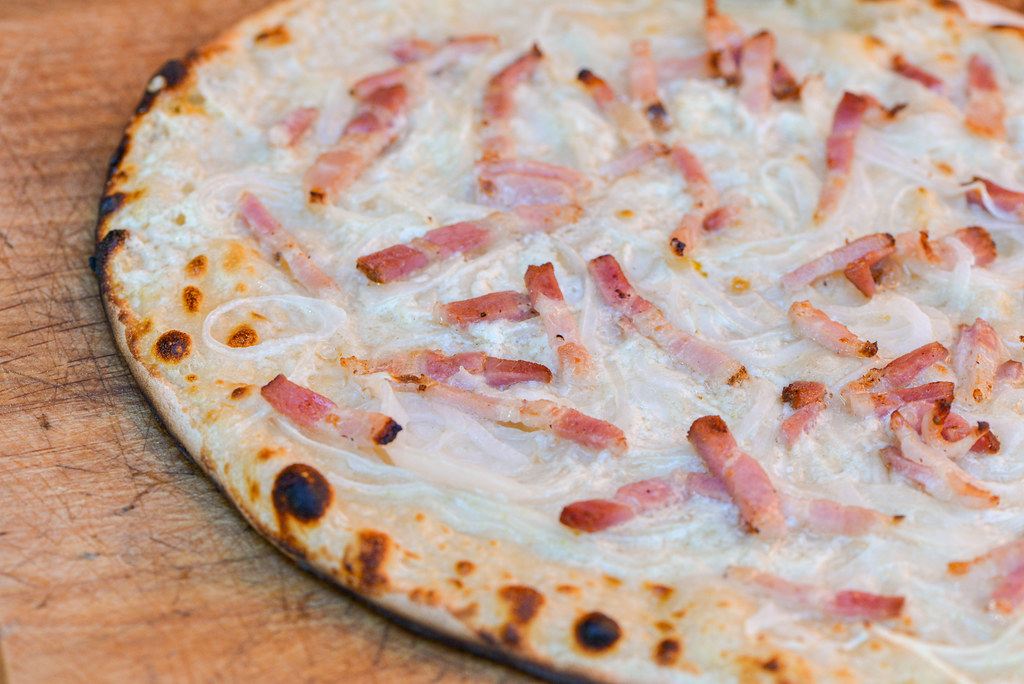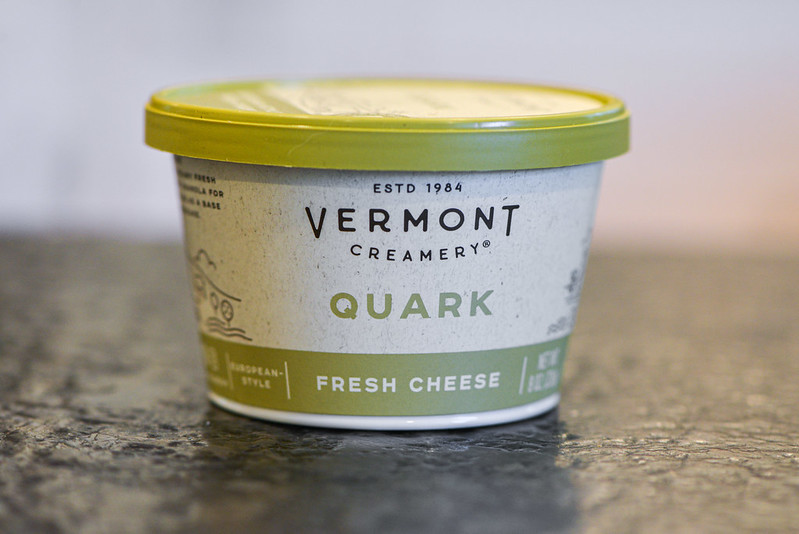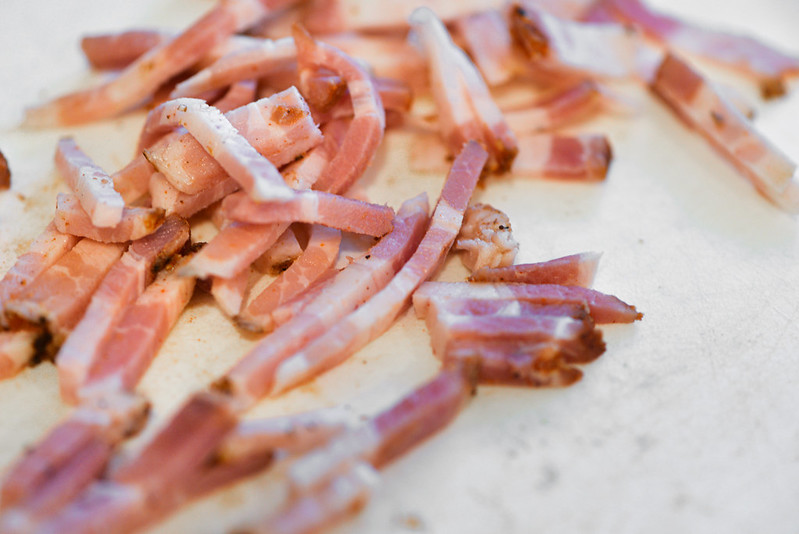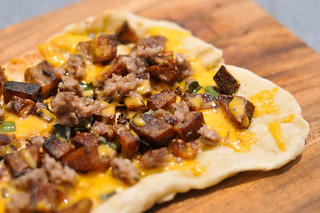Tarte Flambée
I've known tarte flambée—a thin crust, pizza-like flatbread topped with a combo of fromage blanc and creme fraiche, thinly sliced onions, and lardons—mainly as a French dish because I've only experienced it in French restaurants before. This dish does come from the Alsatian region of France, which sits up against the border of Germany and Switzerland, but all three countries have cultural influences that are represented in the tarte flambée, also known as flammekueche in Alsatian. That translates to "pie baked in the flames," which is representative of how it is traditionally cooked—in a coal fired oven when it's at its hottest point. The KettlePizza provides me pretty much that exact cooking experience, so the last time I had it fired up, I gave making tarte flambées a try and wound up with one I've liked better than any I've had in the past.
The main reason tarte flambée has not been something I've cooked before now is because I've never really loved the crust. The few times I've ordered it, it has come on a very thin, cracker-like curst that was dry and I didn't much care for. I figured that's just what this dish is and it was never going to be a favorite of mine, but I learned more recently that need not be the case—it actually just requires bread dough and not something dry and wafer like. When thinking of what I would imagine the perfect dough would be, I landed on New England-style bar pies, whose crust is thin and crispy, yet still substantial and chewy. So to begin, I looked to my old buddy Adam Kuban's bar pie dough recipe to get me headed on the right path.
This isn't a no-knead dough like the Neapolitan recipe I more commonly use, but it's still a very low effort, especially if you have a stand mixer that does the kneading portion in a mere couple of minutes as you only have to look on and watch for the dough to hit the right smooth consistency and slightly shiny appearance. Once it gets there, the dough gets covered and sits out at room temperature for six hours for the first fermentation that develops gluten and flavor.
Next, the dough is divided in four pieces and stored either in a large plastic container, or individual quart-sized containers, and placed in the fridge for the second fermentation. You leave the dough in the fridge anywhere from two to three days, making a little pre-planning necessary to get the best results.
The dough is really the only thing you need to make, the rest of the dish is merely three toppings. Cheese is first, and the classic tarte flambée recipe requires a combo of fromage blanc mixed with creme fraiche. I could not find fromage blanc at any grocery by me, so I looked for alternatives, and found quark most commonly recommended to replace the traditional cheese mixture. So I went with the quark, which is mild flavored cheese that has a texture slightly thicker than regular yogurt.
The next topper is onions, which have to be thinly sliced so they cook quickly during the short stint in the oven. The onions on a tarte flambée should be tender, lightly sweet, and not crunchy or sharp tasting. Using a mandoline to uniformly make very thin slices is ideal to get them thin enough that they'll definitely end up with those desired traits in the end dish.
Finally we have bacon, which needs to be thick enough to be diced into a lardon-type of size. So thick cut is the way to go here and then slicing into thin strips will get you the desired shape and size. I used my homemade spice-cured bacon, but there's no real bonus points or advantage to homemade here except that sometimes it can just be fun to cure and smoke your own pork belly.
When it came to cooking day, I removed the dough from the fridge a couple hours prior to baking it to allow it to come to room temperature. I then prepped the pies as the KettlePizza got heated up so everything would be ready to go when it reached peak temperature. I began by rolling out the dough until it was about an eighth-inch thick, which created and oval roughly twelve by eight inches in size.
I then spread on a layer of quark, using a spoon to push it out towards the edges, but leaving about a half an inch of border for the slightest of crust. Then I put a layer of onions all over and scattered the bacon lardons across the top.
With the charcoal was all lit and the stone well heated, I placed a couple pieces of wood in the back basket of the KettlePizza set-up, and once I could see the flames coming off of those, I placed the tarte flambée in the oven. With the temperature up around 950°F, it only took a couple minutes for it cook, and I rotated the pie a few times in that short period of time to make sure it was browning evenly all the way around.
When I pulled it out of the oven, it was looking mighty fine and pretty perfectly cooked, but I still wasn't all gung ho for it based on lingering ho hum feelings about tarte flambées. That all changed when I took my first bite—I was loving this pizza/not pizza so damn much. The creamy cheese with tender, lightly sweet onions and the salty and smoky bacon all tasted familiar and good, but the dough sealed the deal as this being a truly winning creation for me. The crust had a nice crunch to it with a noticeable char that enhanced the otherwise light touch of the toppings. A mellow tang to the dough also came through and felt very much at home with this particular topping combo. I had gone into this pizza making session throughly prepared to find this the lesser pie of the day, but it ended up being my favorite and I was kicking myself that I had put together four Neapolitan pizzas and only two tarte flambées, leaving two balls of bar pie dough untouched, I would have much rather had two more of these pies. I now finally get why this is a much loved dish and wonder if there's anyone else out there who's also not a fan of the dry cracker crust and just needs to experience a tarte flambée in a similar incarnation as this recipe to finally find the adoration I have.













